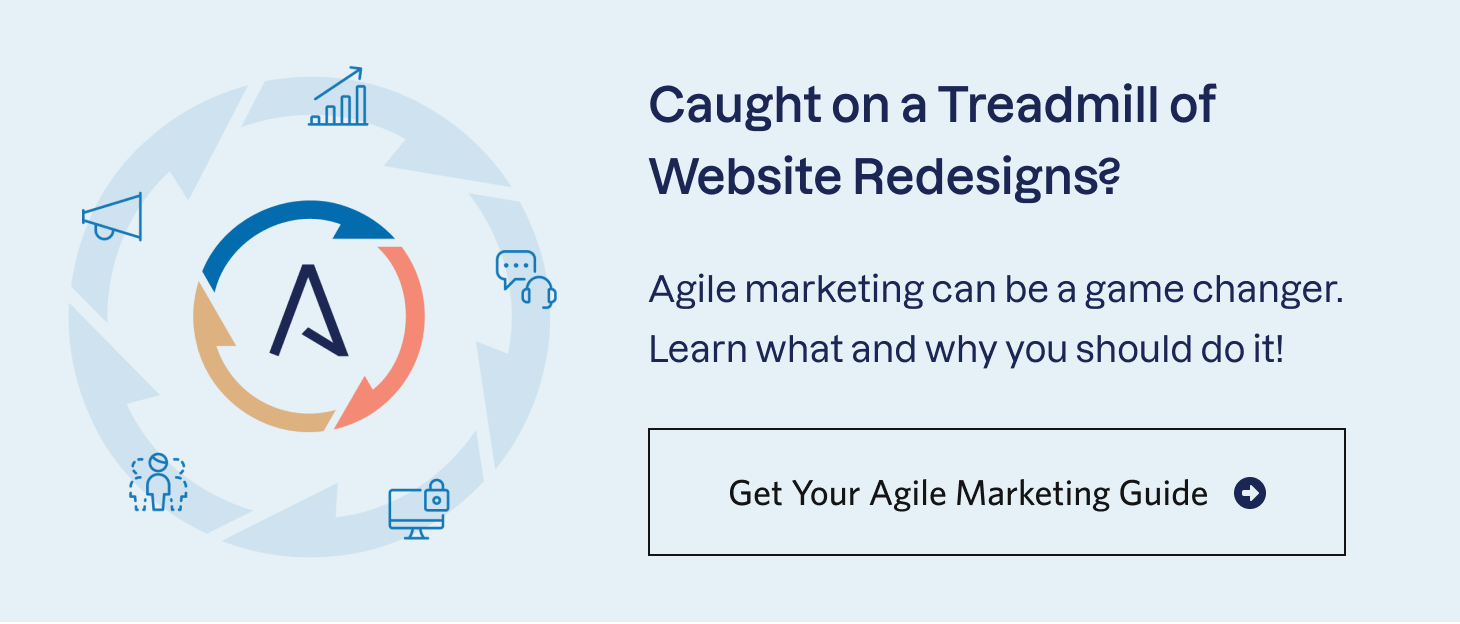A Flexible Approach to Agile Development Will Power Your Redesign Process
In a digital-first economy, a redesign is simply too important to treat like a takeout order. Between the associated costs and the potentially game-changing results, companies recognize the need to stay involved throughout the process. But beyond understanding the importance of collaboration, most organizations want to know what’s happening each step of the way.
The days of blindly trusting the experts to deliver your redesign on time are dead. Welcome to the new era of Agile development for your next website.
If you recognize the term, it’s no wonder—Agile is practically the industry standard for completing software development projects. With the competitive landscape now encompassing apps and mobile experiences, companies recognize Agile as a forward-thinking tool for getting things done. Consequently, savvy marketing leaders want to see the same methods applied to their websites as well.
From the standpoint of creating a successful website redesign, Agile marks a welcome shift in the way design agencies work. However, before you start your next project, you should look beyond the buzzword and know what Agile development really entails. And, just as importantly, why a hybrid approach is likely more appropriate for your business.

Agile vs. Waterfall Workflows in Digital Projects
Not so long ago, agencies designed and developed website projects in linear order. Your project began with a Discovery phase that allowed your agency partner to gather feedback from stakeholders before proceeding. Then, your new website progressed through sequential stages that included Strategy, Design, Development, Testing and Deployment.
With this method, your project progresses in one direction and is dependent on the completion of the preceding stage to move forward—not unlike a waterfall.

Waterfall Development Pros and Cons
As a means of launching a redesign, the Waterfall approach can work really well. If you know exactly what your organization needs, this model is the most efficient way to build a website once all the pieces are in place. All parties know their responsibilities, and your team can be more hands-off during the the actual build process, which culminates in a comprehensive website relaunch.
However, the Waterfall model doesn’t allow for iterative improvement. Your website redesign progresses along a linear path, meaning both you and your agency must make assumptions about its success without the benefit of data informing your decisions. For as much as you invest in a site redesign, you don’t know how well it will perform until it’s live.
However, by applying Agile methodology, you and your design partner collaborate on creating your site with an eye toward continuous improvement.
Agile Development Pros and Cons
Unlike the Waterfall approach, Agile places all of the above stages along a parallel path. Instead of building all of your website at once, your design partner focuses on developing the smallest components as fast as possible. Then, once it’s live, your agency learns from how users respond and begins modifying it until it’s achieving the goals set forth in the Strategy phase.
Under an Agile process, you and your team are involved with every stage including design requirements, approach, and implementation. Review periods are brief, frequent, and fast. Consequently, a successful project requires a deep level of understanding and engagement to move forward on schedule.
Agile methodology embraces iterative improvements that are driven by user feedback and hard data. In practice, it delivers a more successful outcome because your product has been tested, modified, and improved multiple times over. That’s why Agile is used so broadly in software and product development. But it’s a difficult process to adopt for a website design from the beginning.
Not only do your teams need to be fully on board with an ongoing redesign process, but your users do too. Agile requires fast, actionable feedback, and any project’s foundation is built on first launching a skeletal version of your site called an MVP. Short for minimal viable product, your new site then rounds into shape over multiple rounds of revisions.
Given the speed and access that’s required, true Agile development is most effective for in-house teams. So how can your business plan a redesign that incorporates a clear framework while encouraging consistent improvement?

How a Hybrid Agile/Waterfall Process Delivers Stronger Website Designs
At COLAB, we find the best results from a project management approach that borrows from both Waterfall and Agile methods. [Cue sharp inhale from all the Agile purists out there.] Rather than sticking to the bare-bones MVP that sacrifices core functionality, we compromise on the first version of a client’s redesigned website.
Though still minimalist in nature, the first iteration of a redesign will be more functional than true Agile would ordinarily support. To create that initial MVP, we adopt more of a traditional Waterfall model to build the foundation of your new website. Then, that foundation evolves through more effective iterations of your design.
During this initial stage, we also build the foundation for the rest of the collaboration. Through each stage of designing and developing the MVP, we include guides and a glossary of terms for what a client should expect. Depending on your familiarity with your site’s functionality and your team’s availability throughout the process, we can adapt our approach and training to suit your needs.
Tools such as wireframes, mood boards, and UX best practices will all become part of your vocabulary, along with user acceptance testing (UAT) and quality assurance testing (QAT). Our goal is to increase your involvement at every step of the process to prepare you for the next wave of site improvements that lie ahead.
Shifting Toward Agile Delivers Rapid Site Improvements
Though we lean on a Waterfall model to create the first version of your site, we switch gears after the initial launch to a more Agile process. We learn about how users are responding to the site, use A/B testing to make educated decisions, and iterate on the site through a series of sprints. Using a backlog of new features from the initial launch, we also begin working down the list of enhancements.
We set priorities for each sprint and execute them quickly to deploy them to the live site for evaluation from stakeholders and your users. To keep moving forward, your teams need to be available to provide feedback and approval. Otherwise, your website’s progress will be slowed.
From a timing perspective, projects developed with Agile principles take no longer than those created with a Waterfall process. However, your resulting website design is more effective because every component has been tested and proven. If this sounds like a way of working together that will deliver results for your business, we should talk.

